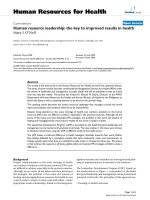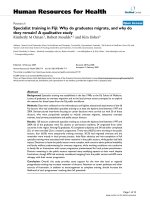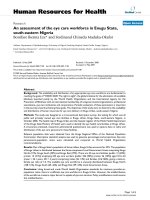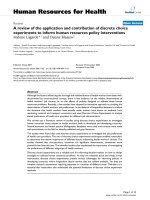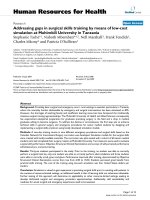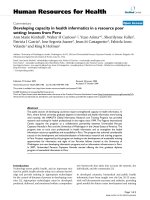Báo cáo sinh học: " Giant viruses in the oceans: the 4th Algal Virus Workshop" docx
Bạn đang xem bản rút gọn của tài liệu. Xem và tải ngay bản đầy đủ của tài liệu tại đây (270.03 KB, 3 trang )
BioMed Central
Page 1 of 3
(page number not for citation purposes)
Virology Journal
Open Access
Short report
Giant viruses in the oceans: the 4
th
Algal Virus Workshop
Jean-Michel Claverie*
Address: Structural & Genomic Information Laboratory, UPR 2589, IBSM, CNRS, 31 chemin Joseph Aiguier, 13402 Marseille Cedex 20, and
University of Mediterranee School of Medicine, 13385 Marseille Cedex 5, France
Email: Jean-Michel Claverie* -
* Corresponding author
Abstract
Giant double-stranded DNA viruses (such as record breaking Acanthamoeba polyphaga Mimivirus),
with particle sizes of 0.2 to 0.6 µm, genomes of 300 kbp to 1.200 kbp, and commensurate complex
gene contents, constitute an evolutionary mystery. They challenge the common vision of viruses,
traditionally seen as highly streamlined genomes optimally fitted to the smallest possible -filterable-
package. Such giant viruses are now discovered in increasing numbers through the systematic
sampling of ocean waters as well as freshwater aquatic environments, where they play a significant
role in controlling phyto- and bacterio- plankton populations. The 4
th
algal virus workshop showed
that the study of these ecologically important viruses is now massively entering the genomic era,
promising a better understanding of their diversity and, hopefully, some insights on their origin and
the evolutionary forces that shaped their genomes.
Report
The 4th Algal Virus Workshop
organized by Corina Brussaard and Herman Gons, and
hosted by the Royal Netherlands Institute for Sea
Research, was held in Amsterdam 17–21 april 2005.
Though marine ecology rather than basic virology was the
main focus of this meeting, exciting new results on the
genomics of large/giant viruses kept turning up in many
talks. In the context of a comparative study, Corina Brus-
saard (in collaboration with the US DoE) is herself
sequencing a variety of Micromonas pusilla and Phaeocystis
globosa dsDNA viruses some of them estimated to have a
genome sizes up to 460 kb.
In his overview, Curtis Suttle (University of British
Columbia, Vancouver, Canada) pointed out that viruses
(including RNA-, DNA-, prokaryotic and eukaryotic
viruses) constitute a significant part of the biomass in
ocean coastal waters (with up to 50 millions particles/ml,
for a total estimate of 25 to 270 Megatons in the oceans)
where they play a dominant role in the control of phyto-
and bacterio-plankton populations, and hence on the
production of oxygen and atmospheric dimethylsulphide,
an important factor in climate regulation. Most of these
viruses are uncharacterized [1].
Ironically, this is in a freshwater unicellular green alga that
the best characterized large DNA virus Paramecium bursa-
ria chlorella virus (PBCV-1), the prototype of the Phycodna-
viridae, was isolated more than 20 years ago in Jim van
Etten's laboratory (University of Nebraska, Lincoln)[2].
Liza Fitzgerald (Van Etten's laboratory) reported on the
ongoing annotation of the genomic sequences of two new
species of Paramecium bursaria chlorella viruses: NY-2A
(infecting PBCV-1 host Chlorella species NC64A) and
Chlorella Pbi virus MT325. NY-2A genome contains
368,683 bp, making it the largest chlorella virus
sequenced to date. Despite a 10% difference in size, the
Published: 20 June 2005
Virology Journal 2005, 2:52 doi:10.1186/1743-422X-2-52
Received: 01 May 2005
Accepted: 20 June 2005
This article is available from: />© 2005 Claverie; licensee BioMed Central Ltd.
This is an Open Access article distributed under the terms of the Creative Commons Attribution License ( />),
which permits unrestricted use, distribution, and reproduction in any medium, provided the original work is properly cited.
Virology Journal 2005, 2:52 />Page 2 of 3
(page number not for citation purposes)
NY-2A genome and PBCV-1 genome (330 kb) exhibits a
near perfect colinearity. With 314,335 bp the MT325
genome is slightly smaller and does not exhibit long range
colinearity with the PBCV-1 and NY-2A genomes. As in
previously sequenced phycodnaviridae, new unexpected
functions turned up to be encoded is these two new
genomes, such as the first aquaglycerolporin the activity
of which has been experimentally verified. A detailed
comparative proteomics of the three viral particles (each
of them exhibiting about 120 virus-encoded polypep-
tides) is also under way in the same laboratory (D. Duni-
gan et al.).
It was known for some time that filamentous marine
brown alga of genus Feldmannia were infected by large
dsDNA viruses (phaeovirus) coming in two genome sizes:
158 kbp and 178 kbp [3]. Prof. T-J. Choi, (Pukyong
National University, Busan, Korea) reported on the com-
pletion of the genome sequencing of the "short" form of
FsV infecting Feldmannia sp. The final sequence size is
153,259 bp (51.8 G+C). About 50% of the 161 predicted
ORFs have their best matching homologues in Feldmannia
irregularis virus (FirrV-1) or Ectocarpus Siliculosus virus
(EsV-1). Nicolas Delaroque (Max Plank Institute for
Chemical Ecology, Jena, Germany) reported on the diffi-
Scanning Electron Microscopy picture of Emiliania huxleyi [9]Figure 1
Scanning Electron Microscopy picture of Emiliania huxleyi [9]. Alien looking E. huxleyi is the host of phycodnavirus EhV-
86, the 407-kb genome of which was sequenced at the Sanger center [10].
Publish with BioMed Central and every
scientist can read your work free of charge
"BioMed Central will be the most significant development for
disseminating the results of biomedical research in our lifetime."
Sir Paul Nurse, Cancer Research UK
Your research papers will be:
available free of charge to the entire biomedical community
peer reviewed and published immediately upon acceptance
cited in PubMed and archived on PubMed Central
yours — you keep the copyright
Submit your manuscript here:
/>BioMedcentral
Virology Journal 2005, 2:52 />Page 3 of 3
(page number not for citation purposes)
culty to reach full closure in sequencing the genome of
Feldmannia irregularis virus (FirrV-1), most probably due
to the presence of long repeats. The current FirrV genome
sequence data consists of 191,667 bp (in 16 contigs),
encoding 156 putative proteins [4]. His more recent
experiments suggest that FirrV infection may lead to the
release of a mixture of virus forms associated with a wide
range of genome sizes (from 192 kbp to 10 kbp).
Dr Keizo Nagasaki and his collaborators (National
Research Institute of Fisheries, Hiroshima, Japan)
announced the near completion of the 356 kbp-genome
sequence of HcV01, a dsDNA virus infecting dinoflagelate
Heterocapsa circularisquama, and of the 294 kbp-genome
sequence of Heterosigma akashivo infecting virus (HaV01).
The same laboratory is also finishing the sequencing of
the 145 kb-genome of T4-like looking cyanophage Ma-
LMM01, infecting the toxic cyanobacterium Microcystis
aeruginosa.
Finally, Willie Wilson's group (Plymouth Marine Labora-
tory, UK) claimed the bronze medal in the fierce competi-
tion for genome size [5]. They presented the complete
genome sequence of Coccolithovirus EhV-86, a ds-DNA
infecting alien-looking calcarous nanoplankton Emiliania
huxleyi (Fig. 1). The genome is made of 407,339 bp
(40.2% G+C) and encodes 472 putative protein coding
regions. Only 66 (14%) of them have recognizable homo-
logues in the public databases. As other giant viruses, EhV-
86 exhibits its share of unexpected genes and functions,
most notably a number of enzymes involved in the bio-
synthesis of sphingolipids. Albeit phylogenetically
branching at the root of the Phycodnaviridae (e.g. PBCV-1
or EsV), EhV-86 does encode it own DNA-dependent RNA
polymerase complex, thus filling the gap with the other
Nucleo-Cytoplasmic Large DNA virus families (Irido-,
Asfar-, Pox-, and Mimi-viridae) that all exhibit virally-
encoded RNA-polymerases. Pending approval by ICTV,
EhV-86 might become the prototype of the coccolythovir-
inae, a new subfamily of phycodnaviridae.
In his closing lecture, Jim Van Etten, reminded the new
comers in the field of algal viruses that reports of very
large icosahedral virus-like particles in various aquatic
and marine organisms can be traced back to the 50's, but
failed to elicit much interest outside of the community of
marine biologists. The discovery and genome characteri-
zation of the large freshwater chlorella viruses [2], and
more recently of giant amoeba infecting Mimivirus [6]
(remotely related to phycodnaviruses but not an algal
virus) elicited a renewed interest in the genomics of these
large marine viruses, as they may provide new insight on
the early evolution of eukaryotes. Not unexpectedly, close
relatives of Mimivirus appear to exist in the marine envi-
ronment, as suggested by the numerous homologous
sequences found by J M. Claverie and E. Ghedin (The
Institute for Genomic Research, Rockville, USA) in their
exhaustive analysis [7] of the Sargasso Sea environmental
data set [8].
The 4th Algal Virus Workshop made it clear that these
giant algal viruses are now entering the genomic era at full
speed. The amount of surprises that we can expect while
deciphering their genomes will be as big as their diversity,
and more dogma on what a virus should look like will
probably be shattered along the way.
Acknowledgements
Thanks to the participants and organizers of the 4
th
algal virus workshop
/> for allowing some of their unpublished work to be
mentioned in this article.
References
1. Suttle C: The viriosphere: the greatest biological diversity on
Earth and driver of global processes. Environ Microbiol 2005,
7:481-482.
2. Van Etten JL: Unusual life style of giant chlorella viruses. Annu
Rev Genet 2003, 37:153-195.
3. Ivey RG, Henry EC, Lee AM, Klepper L, Krueger SK, Meints RH: A
Feldmannia algal virus has two genome size-classes. Virology
1996, 220:267-273.
4. Delaroque N, Boland W, Muller DG, Knippers R: Comparisons of
two large phaeoviral genomes and evolutionary
implications. J Mol Evol 2003, 57:613-622.
5. The giantvirus web site [
]
6. Raoult D, Audic S, Robert C, Abergel C, Renesto P, Ogata H, La Scola
B, Suzan M, Claverie JM: The 1.2-megabase genome sequence of
Mimivirus. Science 2004, 306:1344-1350.
7. Ghedin E, Claverie JM: Mimivirus Relatives in the Sargasso Sea.
Virol J 2005 in press.
8. Venter JC, Remington K, Heidelberg JF, Halpern AL, Rusch D, Eisen
JA, Wu D, Paulsen I, Nelson KE, Nelson W, Fouts DE, Levy S, Knap
AH, Lomas MW, Nealson K, White O, Peterson J, Hoffman J, Parsons
R, Baden-Tillson H, Pfannkoch C, Rogers YH, Smith HO: Environ-
mental genome shotgun sequencing of the Sargasso Sea. Sci-
ence 2004, 304:66-74.
9. Earthguide.image library, Coccolithophore – Emiliania hux-
leyi [ />huxleyi.html]
10. The Wellcome Trust Sanger Institute Emiliania huxleyi virus
86 project [ />]

